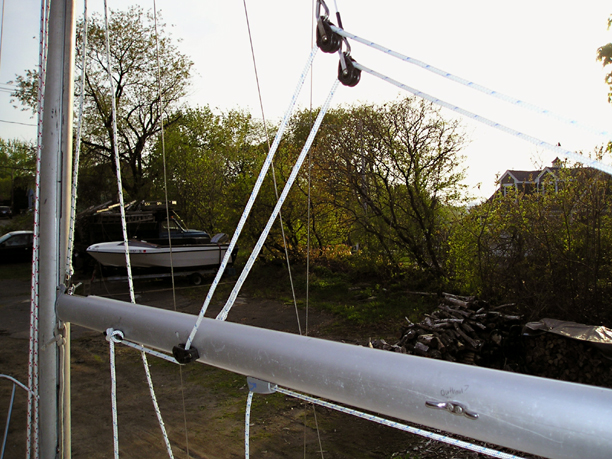Lazy Jack Installation


USING LAZY JACKS. The most common problem encountered when using lazy jacks on a mainsail is fouling the headboard and battens while hoisting the main. Amazon. Easystore 4.0 Crack Serial. com: Nautos 001 - LAZY JACK TYPE A - SMALL SIZE - for sailboats up to 31'- kit: Sailing Hardware: Sports & Outdoors. Was very easy to install.
Lazy-jacks: Mainsail tamers By Guy Stevens Article taken from Good Old Boat magazine: Volume 4, Number 4, July/August 2001. Take the pain out of the main, make your own lazy-jacks The easiest way for the shorthanded sailor to control the mainsail when reefing or stowing is a set of well-fitted lazy-jacks. Origin 9 Crack. Lazy-jacks are made from a set of fixed or movable lines led from the upper section of the mast to the boom, with lines on each side. They guide the sail onto the top of the boom when reefing or dousing it and keep it there to be tied up at the crew's leisure.
When properly installed, a lazy-jack system adds to safety and sail control. Lazy-jacks function well with sails with no battens, half battens, or full battens. When installed and used correctly, they prevent chafe and tearing. A well-thought-out installation makes the lazy-jacks convenient to use, puts them out of the way when stowed, and does not require expensive alterations of sails or sail covers. There are several varieties of lazy-jacks. The fixed systems permanently attach to the mast and are not stowed. These require altering the sail cover, may chafe the sail while sailing, and sail battens may catch in the lazy-jacks, making hoisting difficult.
The better systems allow the lazy-jacks to be stowed and are deployed only when the sail is being doused or reefed. Off-the-shelf and custom-built lazy-jack systems are available. Sail-loft versions start at $200; mid-range systems cost about $400; and high-end systems can cost $1,500 or so if professionally installed. A scratch-built system can be fabricated for less than the cheapest off-the-shelf systems, and has some advantages in the way it fits and functions with your boat. Not always better The off-the-shelf systems are not necessarily better designs. Inside The Actors Studio S15 more.
Most off-the-shelf systems use blocks at their segment junction points. When stowed, these blocks may bang on the mast. Correcting this situation requires the installation of hooks on the mast or boom and sections of shock cord to pull the support segment away from the mast. The need for blocks at the segment junctions is questionable, and they are more costly than thimbles. Systems that use a line through the sail can cause sail chafe and require modifications to the sail and cover. Since the average do-it-yourself sailor can't perform these modifications, the work can be expensive. These lines can also interfere with the shape of the sail when set.
Changing the sail requires re-threading the lines through the sail each time it is changed or removed, neither a quick nor an easy task. Some systems use shock cords to support the leg segments of the lazy-jacks.
However, the shock cord provides too much stretch, and the sail may fall out of the lazy-jacks. Most of these systems use a plastic clip-on fitting to secure the lazy-jacks to the boom and mast. This plastic deteriorates in sunlight and often fails within a season or two. With about an hour more than you would invest in the installation of an off-the-shelf lazy-jack system, you can make your own custom set, tailored to your boat. By buying the individual components, you can create a custom system for less than $175 (see parts list). Four choices he line you select should match your splicing abilities and rig construction.
There are four types to choose from: three-strand nylon; three-strand Dacron, standard double yacht braid, and more exotic fibers, such as Sta-Set X or Spectra line. Lazy-jacks made of three-strand nylon for the average boat can be assembled for about $91. The same lazy-jacks in Sta-Set would cost about $160. Don't let cost be the only deciding factor; each line has advantages and disadvantages. Three-strand nylon is simple to splice, requiring no tools and little knowledge.
It's inexpensive and available from most chandlers for 13 cents a foot or less for 1/4-inch diameter. However it is stretchy, so it is not as well-suited for high-aspect-ratio rigs where the stretch could allow the sail to fall off of the top of the boom. It's susceptible to chafing where it contacts other lines, and it may cause twisting when deploying the lazy-jacks, necessitating the untwisting of the support lines. While this is the cheapest line, with the most disadvantages, it served well on my 39-foot racer/ cruiser for more than five years, until recent replacement with double yacht braid. I've constructed a number of lazy-jack systems using three-strand nylon for people who wanted to spend as little as possible on the initial trial of the lazy-jack system. Each system I created with three-strand nylon has occasionally required some intervention to untwist the support lines.